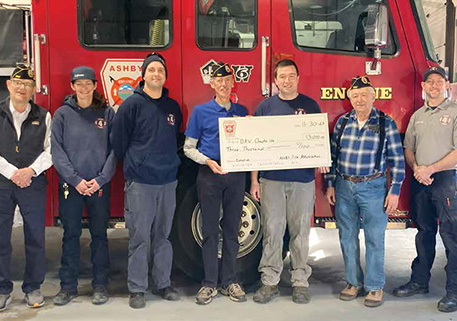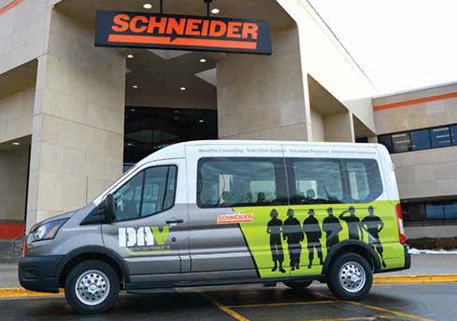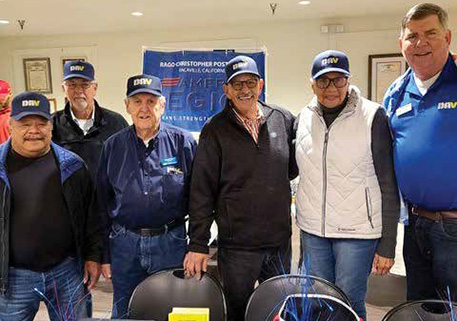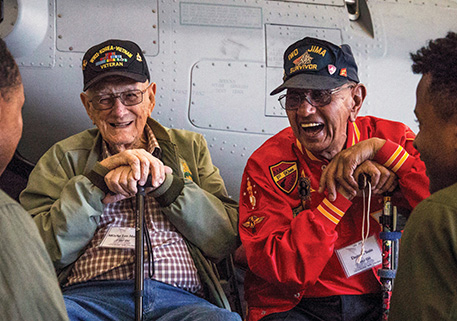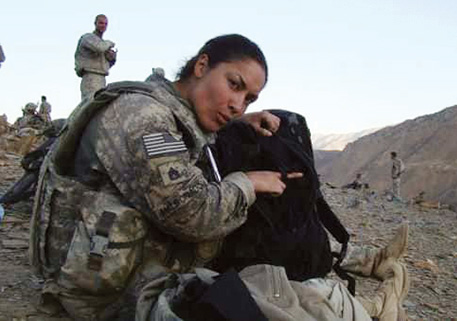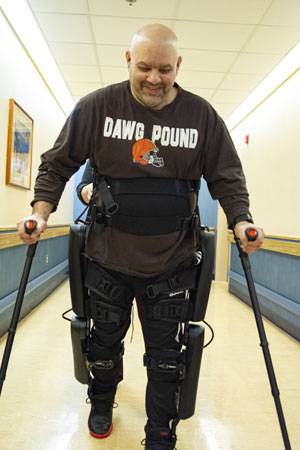
VA, veterans test state-of-the-art equipment to ease symptoms associated with spinal cord injuries
When an individual sustains a spinal cord injury (SCI), there is a litany of secondary medical conditions that can develop from the resulting immobility, further complicating the road to recovery.
Some of those complications include low bone density and an increased risk of developing osteoporosis, poor bowel and bladder function, muscle atrophy, and an increase of fat tissue. An increase of fat tissue can bring with it all of the same health issues of obesity without the patient looking overweight. These conditions can open up an even wider web of health concerns, which makes a preventive approach a critical element of the treatment plan.
Yet there is hope for the estimated 42,000 veterans who have sustained a SCI—and the solution looks straight out of science fiction.
The Department of Veterans Affairs is studying powered exoskeleton technology, which recently became available as an alternative form of upright mobility to veterans with SCI, providing an external framework for support and computer-controlled motorized hip and knee joints to assist with walking. The study comes at an important time, as the VA is currently the largest health provider to individuals with SCI in the nation, and injuries to the spine are on the rise among post-9/11 veterans.
According to a recent report, “Epidemiology of War-Related Spinal Cord Injury Among Combatants: A Systematic Review,” the frequency of spinal cord injuries of all war casualties was estimated to be 1.2% in the Korean War and 1% in both the Vietnam War and the Gulf War. More recently, it has been reported that more than 1 in 10 wounded Iraq and Afghanistan combatants have sustained an SCI. Presently, spine-related disabling conditions account for 14% of medical discharges from wartime military service.
“When people have a spinal cord injury, it’s not just the ability to move their limbs that is impacted,” said Dr. Kristi Henzel, who oversees the study at the Cleveland VA Medical Center. “The brain stem, the brain and the spinal cord control all of the body’s organs, so there are a lot of other things that can become dysfunctional from an SCI. These additional complications all have a negative impact on the patient’s longevity.”
The study is available to eligible veterans with SCI who pass the screening criteria. The targeted enrollment is 160 veteran participants across 15 different VA medical centers. Half the veteran participants will use the exoskeletons, and their progress will be measured against the other 80 participants who will use wheelchairs. For initial safety reasons, the veterans using the exoskeletons require a trained companion in order to use the devices at home.
“The veterans in the study group take the device home for 16 weeks, and during that time, they use the device as little or as much as they want,” Henzel said. “The goal of the study is to help figure out how people are using it, how much using the device changes their quality of life and their activity level.”
In 1993, DAV life member Harry Hillen Jr. was medically discharged from the Air Force as a result of his wartime service. In 2008, he was celebrating his third wedding anniversary and the birth of his second child when his future as a husband and a father was threatened by the discovery of a cancerous tumor on his spinal cord.
“I had a lot to live for, but you never know what could happen to you at that point,” said Hillen, who is a member of DAV Chapter 58 in Hopwood, Pa. “It was pretty much a 50-50 chance if I was going to walk again, or even wake up from the surgery.”
Hillen successfully had the tumor removed, but it returned in 2011. He again had it removed and is now cancer-free and participating in the study.
“I did physical therapy for three months after surgery,” Hillen said. “I was able to get to the point of walking with a walker, but I never progressed past that point. Then I got something in the mail about this opportunity and thought this could be something that really benefits me.”
Hillen’s final diagnosis is classified as an “incomplete spinal cord injury.” Put simply, an incomplete SCI occurs whenever a survivor retains some feeling below the site of the injury.
“It has improved my ability to play with my kids, because my legs have gotten stronger,” Hillen said. “When my daughter was born, one of my big things was that I wanted to be able to walk her down the aisle one day. That was my motivation that kept me going, and this device is helping ensure that happens.”
All of the participants in the study are using a powered exoskeleton, ReWalk 6.0, which is customized to fit each veteran properly.
“To begin use of the device, a person would transfer into it while it is seated,” said Andy Dolan, vice president of marketing at ReWalk.
Users buckle in and use a set of crutches positioned at their sides. The ReWalk takes physical cues from the user, as well as prompts from a wrist-worn remote control, to assist the user in sitting, standing and walking using knee and hip motors and a programmed stepping algorithm.
“It’s difficult at first,” Hillen said. “The first time I put it on, it was a little scary. You know, it is new. You get a little bit nervous, wonder if you’re going to fall, but being able to make the leg movements that you would normally make is pretty amazing. It gives you the hope to keep going. I can see and feel my legs being able to do more than before.”
“Studies like this show us what an important impact VA research has on the lives of disabled veterans,” said Deputy National Legislative Director Adrian Atizado. “Especially as we’re seeing such a significant increase in SCIs among this current generation of warfighters, we must continue advancing technology that will give them the greatest quality of life possible.”
“This study is particularly exciting because, while others have had very encouraging results, this is the first to study individuals with SCI using these devices at home for a multi-month period,” Dolan said. “The VA’s funding and execution of this study is a crucial step in understanding the impact exoskeletons can have on a person’s quality of life and the reduction of their secondary medical complications.”
For Hillen, the ultimate goal is to be able to walk again and do more with his kids.
“Even if I can never walk again, it is amazing to be able to use it and be more active,” Hillen said. “It definitely gives you hope. It has given my kids hope also to go through it with me. I think it has made them stronger.”
The study has an estimated completion date of Sept. 30, 2021, but Hillen’s wife, Heather, said she has already seen improvement.
“The device gave him the help he needed to be able to stand up and take actual steps,” she said. “The look on his face when he is using the ReWalk is a look of accomplishment. The pride he showed when he learned how to operate it was a face I had missed seeing. I have felt our family getting closer to him as a husband and a father.”
Hillen is hopeful that the study will prove to be beneficial and therefore help more of his fellow veterans in the future.
“It’s all about seeing what it can do for other veterans,” Hillen said. “It’s about other veterans and improving their lives. Many veterans are worse off than I am, and I think this technology is pretty awesome.”

